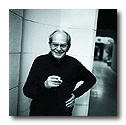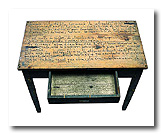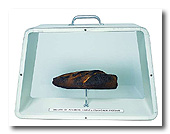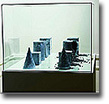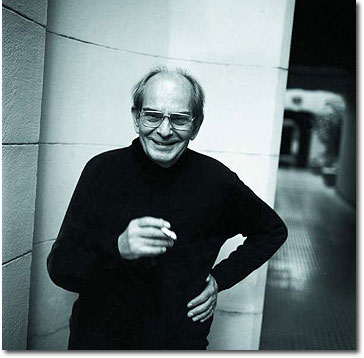Museo de Arte Latinoamericano de Buenos Aires,
Jun 25, 2004 - Sep 06, 2004
Buenos Aires , Argentina
Víctor Grippo (1936-2002
by Viviana Usubiaga
The retrospective exhibition of Victor Grippo at the Latin American Art Museum in Buenos Aires - Constantini Collection curated by Marcelo Pacheco closed last September 6th. The show brought together close to one hundred works, including objects, installations, works in progress, photographic documentation of his urban projects, boxes, settings, the reconstruction of ephemeral pieces by the artist and the presentation of large format installations such as Mesas de trabajo y reflexión, prepared for the 1994 V Havana Biennial -subsequently presented in Documenta 11, at Kassel, Germany, in 2002- La intimidad de la luz en St. Ives, and De un lado y del otro made in 1997 at the Tate Gallery in St. Ives, England. This was the first large retrospective exhibition dedicated to Grippo in Argentina since the show at the San Telmo Foundation in Buenos Aires in 1988. Other shows major shows were at the Ikon Gallery of Birmingham, England, and at the Palais des Beaux-Arts, Brussels, Belgium, in 1995. Víctor Grippo (1936-2002) is recognized as one of the principal protagonists of conceptual art in its ideological form or, better still, of conceptualismo caliente, a notion adjusted by M. Pacheco which appraises the density of significances and emotive complexity of his work, as opposed to the severity of conceptual art in other latitudes. Grippo was born in the province of Buenos Aire and studied chemistry at the National University in La Plata and attend courses on Vision given at the Escuela Superior de Bellas Artes by Professor Héctor Cartier. He began his career as painter and engraver in 1957, when he took part in the Salón de Arte at Tandil, where he was doing his military service. In the sixties he worked with sculpture simultaneously as he was exploring engravings and oil and synthetic lacquer paintings. It’s around this time, he began his studies of synthetic objects and constructions with motor and light mechanisms. His first individual exhibition took place at the Lirolay Gallery in Buenos Aires in 1966. During the latter part of 1971 he formed the Group of Thirteen in conjunction with Jacques Bedel, Luis Benedit, Gregorio Dujovny, Jorge González Mir, Carlos Guinzburg, Vicente Marotta, Luis Pazos, Juan Carlos Romero, Julio Teich, Horacio Zabala and Alfredo Portillos, under the coordination of Jorge Glusberg - which was invited to the XIV San Paolo Biennial and won the Gran Premio Itamaraty in 1977. Grippo continued his involvement in its subsequent formation as the Grupo CAYC up to 1979. ’I am a homo faber’, Grippo was wont to say, with the certainty of being able to transform matter through his trade. This resulted in his cult of objects and work tools, and his unique "cosmovision" which combined the different forms of knowledge obtained from science, popular culture, poetry, alchemistry, philosophy and literature. His works were conceived as evidence of the possibility of modifying consciousness and, as a result, the surrounding reality through our activities. The showcase began with a series dedicated to his first works linked to experimentation on the energy of matter. Quoted on the introductory wall were the words spoken by Grippo at his 1988 retrospective exhibition: "I would have wished this showcase to form a clear thread ascending from the tripod on which my father exercised his Sunday operations and descending to the pot in which my mother stirred the food (both operators of fire and nutrition, of what should be observed, transformed, kept or distributed). "Garlic and onion (and potato) eaters" they forged a difficult and uplifting reality which perhaps determined my trade; and I have not perhaps accomplished much more than the sense transmitted ..." .
|
